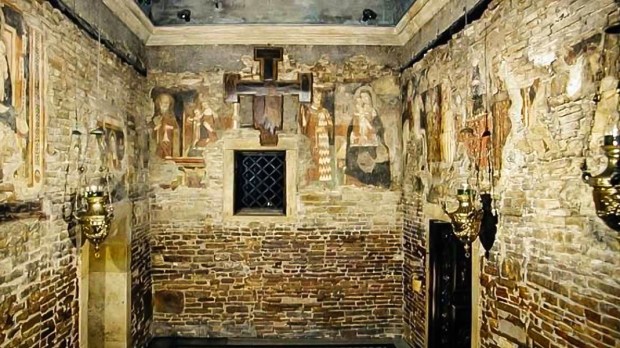Loreto is a small town on Italy’s west central coast. It offers lovely views of the Adriatic Sea but it is most known because of the Virgin Mary’s association with the town, as Our Lady of Loreto.
Devotion to Our Lady of Loreto traces back to an account of a miraculous transfer of the Virgin’s home from Nazareth to this small Italian village.
That small home, known as the Holy House, where the young virgin received the visit of the Angel Gabriel and where God became man, is a simple abode made of stones.
It had become a relic protected by the Christians of the Holy Land from the first centuries after Christ, since under the roof of that humble space it was announced that Our Lord would be great and would be called Son of the Most High, and that the Lord God would give him the throne of David his father, and he would rule over the house of Jacob forever, and of his kingdom there would be no end.
Some traditions hold that in that same house, the Holy Family also lived.
Centuries later, in 1291, during an epoch of great Islamic expansion, it is said the house inexplicably disappeared. Just as inexplicably, it appeared in the city of Trsat, in present day Croatia. The priest of the area, shocked at the sudden appearance of the structure, received a message from Our Lady in a dream. She told the priest that it was the house where Jesus had been conceived by the Holy Spirit, and that as as sign, the dear pastor would be healed of a disease he had long suffered. This came to pass.
The people began to make pilgrimages to the place, and received many graces and miracles. Local officials sent envoys to the Holy Land to determine if the house had really come from there. It is said that once in Nazareth, they discovered only the foundation of the house, and the shock of the Nazarenes at the disappearance of the house. The foundations had the same measurements of the house now in Trsat. (This foundation is still conserved today in the Basilica of the Annunciation in Nazareth). The house in Trsat, meanwhile, was intact and showed no signs of having been deconstructed and rebuilt.
Some three years later, a new miracle occurred: On Dec. 10, 1294, the house was again moved, and resettled in the forests of Loreto.
The faithful recalled a prophecy of St. Francis of Assisi, that Loreto would one day be one of the most sacred cities of the world and that a basilica in honor of Our Lady would be built there.
Certain things about the structure in Loreto are notable:
- The rocks from which it is made are not local to Italy; they are however local to the region of Nazareth in the Holy Land
- The door is made of cedar, a wood also not found in Italy, but also local to Palestine
- The stones of the walls are structured with a type of cement typical of Palestine in the times of Jesus, but not used in Italy at the time that the house appeared in Loreto
- The measurement of the house perfectly corresponds to the measurement of the foundation that was left in Nazareth
- The house — small and simple — was typical of the area in the time of Jesus
Our Lady of Loreto is the patroness of aviation, in reference to the miracle of her house.
LEARN MORE
Our Lady of Walsingham, in England, is also associated with the Holy House.
In 1061, a Saxon noblewoman, the widow of the lord of the manor of Walsingham Parva, Lady Richeldis de Faverches, was asked by Our Lady in a vision to build a replica of the Holy House. Our Lady transported Richeldis in the vision to Nazareth, to show her the home. She was shown the house three times and told to note the measurements.
After prayer and overcoming various adversities, the house was built and Walsingham became known as “England’s Nazareth.”
The original shrine stood until Henry VIII destroyed it. Walsingham was one of the great places of pilgrimage of the Middle Ages.

